Wildlife photography
Wildlife photography is a genre of photography concerned with documenting various forms of wildlife in their natural habitat.
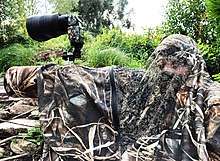
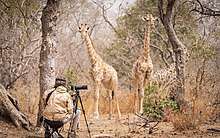
.jpg)
As well as requiring photography skills, wildlife photographers may need field craft skills. For example, some animals and birds are difficult to approach and thus a knowledge of the animal's and birds behavior is needed in order to be able to predict its actions. Photographing some species may require stalking skills or the use of a hide/blind for concealment.
While wildlife photographs can be taken using basic equipment, successful photography of some types of wildlife requires specialist equipment, such as macro lenses for insects, long focal length lenses for birds and underwater cameras for marine life. However, a great wildlife photograph can also be the result of being in the right place at the right time[1] and often involves a good understanding of animal behavior in order to anticipate interesting situations to capture in photography.
History
In the early days of photography, it was difficult to get a photograph of wildlife due to slow lenses and the low sensitivity of photographic media.[2] Earlier photos of animals were usually pets, stuffed[3], and zoo animals.[4][5] These included photos of lion cubs taken at the Bristol zoo in 1854 and in 1864, photos of the last Quagga by Frank Hayes.[6] Wildlife photography gained more traction when faster photography emulsions and quicker shutters came in the 1880s.[7] Developments like these lead to photos such as the ones taken by German Ottomar Anschutz in 1884, the first shots of wild birds in action.[7] In July 1906, National Geographic published its first wildlife photos.[8] The photos were taken by George Shiras III, a U.S. Representative from Pennsylvania. Some of his photos were taken with the first wire-tripped camera traps.[9][10]
Definition
The world's three largest photography organisations, the Photographic Society of America, the Fédération Internationale de l'Art Photographique and the Royal Photographic Society have adopted a common definition for nature and wildlife photography to govern photography competitions, their respective presidents writing in a joint statement, "The development of a common definition for nature and wildlife photography will be an important step in helping photographers, many of whom enter competitions internationally, know what the rules are. It will also provide organisers with a very clear definition when they need to deal with the problem of ineligible images."[11]
Equipment
Equipment for wildlife photography can be very specialized and often uses different lenses and equipment than most other disciplines. Most wildlife lenses have a very long focal length between 150mm and 600mm, allowing the photographer to get a tighter image filling the frame with their chosen subject. However, whilst the majority of wildlife is shot with a telephoto lens, when a wide-angle lens is used, it can provide striking shots of animals within their environment.[12]
Some other specialized gear includes camera traps, hides, ghillie suits and flash extenders.
Examples
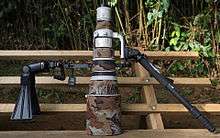
 Monkey's affection
Monkey's affection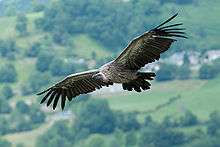 Griffon vulture (Gyps fulvus), France
Griffon vulture (Gyps fulvus), France- Deer, Thrunelly Forest, Wayanad, Kerala
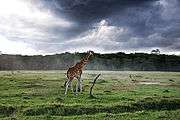
- Kerala bison, Bison Valley, Parambikulam, Kerala
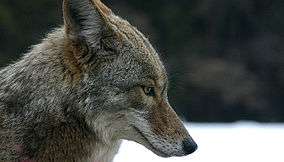 Coyote (Canis latrans), Yosemite National Park
Coyote (Canis latrans), Yosemite National Park_running.jpg) Eurasian brown bear (Ursus arctos arctos), Denmark
Eurasian brown bear (Ursus arctos arctos), Denmark- Monkey at Wayanad, Kerala
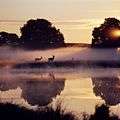 Harry Opstrup, Dyrehaven, 1970
Harry Opstrup, Dyrehaven, 1970
See also
- BeetleCam
- Digiscoping
- Escape distance of animals
- High-speed photography
- National Wildlife Magazine
- Nature photographers
- Nature photography
- Project Noah
- Wildlife observation
References
- "animal picture society". animal picture society. Retrieved 7 February 2016.
- "Answers - the Most Trusted Place for Answering Life's Questions".
- Brower, Matthew (2011). Developing Animals: Wildlife and Early American Photography. ISBN 9780816654789.
- http://www.markcarwardine.com/uploads/articles/bbc_wildlife/history_wildlife_photography.pdf
- "A Brief History of Animals in Photography". 2015-06-04.
- Cox, Rosamund Kidman, ed. (2014). Wildlife Photographer of the Year. Firefly Books. p. 13.
- Cox, Rosamund Kidman, ed. (2014). Wildlife Photographer of the Year. Firefly Books.
- http://photography.nationalgeographic.com/photography/photographers/first-wildlife-photos.html
- http://photography.nationalgeographic.com/photography/photographers/digital-camera-trap-article.html
- "These Were the First Wildlife Photographs Published in National Geographic".
- http://rps.org/news/2014/may/nature-definition-agreed Accessed 25 May 2014
- Hamblin, Mark (2016-08-28). "How to Photograph Animals in Their Habitat". Nature TTL. Retrieved 2019-08-06.